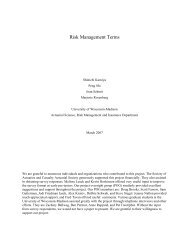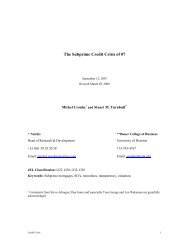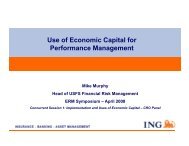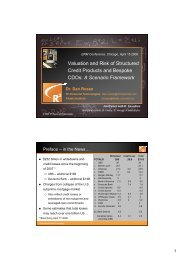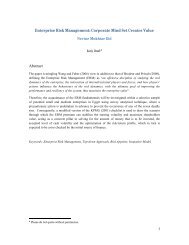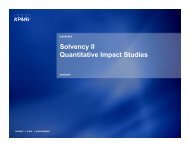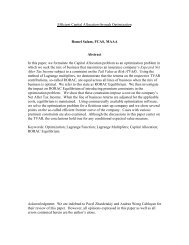Bayesian Risk Aggregation: Correlation ... - ERM Symposium
Bayesian Risk Aggregation: Correlation ... - ERM Symposium
Bayesian Risk Aggregation: Correlation ... - ERM Symposium
You also want an ePaper? Increase the reach of your titles
YUMPU automatically turns print PDFs into web optimized ePapers that Google loves.
The Metropolis-Hastings algorithm requires an appropriate proposal density. In gen-<br />
eral, the Metropolis-Hastings algorithm works more successfully when the proposal density<br />
is at least approximately similar to the target density, i.e. the full conditionals (3.9). As-<br />
suming that the length n of the empirical time series is relatively short, we may suppose<br />
that the shape of the full conditional posteriors (3.9) are mainly impacted by the full<br />
conditionals of the correlation matrix priors, i.e. by<br />
π(ri|rj, i = j) ∝ πi(ri) 1 {Ri(ri)∈R 4 }, i = 1, . . . , 6, ri ∈ [0, 1] . (3.10)<br />
Therefore, when deploying the one-dimensional independent Metropolis-Hastings al-<br />
gorithm to sample from (3.9), it may be justified to chose the full conditionals (3.10) as<br />
proposal densities. An alternative proposal are uniform distributions. It should be men-<br />
tioned that the question regarding which proposal distribution works best can only be<br />
answered in the context of the concrete data at hand. In our exercise below, we found that<br />
proposals of the form (3.10) are superior to a uniform distribution when beta distributed<br />
priors are used (Exercise 3.2). However, in case of triangular shaped priors (Exercise 3.3)<br />
either a uniform distribution or the full conditional priors are suitable proposal densities<br />
and lead to good convergence of the MCMC simulation (see Appendix 6.1).<br />
When sampling ri, i = 1, . . . , 6, from (3.9) one has to account for the fact that the<br />
resulting matrix R must be positive semidefinite. In order to achieve a maximum com-<br />
putational efficiency, it would be good to know what values of ri, given all the other<br />
correlations rj, j = i, keep R positive semidefinite. Following Barnard et al. [1] we remark<br />
that the indicator function 1 {Ri(ri)∈R 4 } whose evaluation involves computations of deter-<br />
minants can be rewritten as 1{ri∈[ai(rj,j=i),bi(rj,j=i)]} for all i = 1, . . . , 6. Here, ai(rj, j = i)<br />
and bi(rj, j = i) are the roots of the two-grade polynomial det(Ri(ri)) = 0 with Ri(·) as<br />
defined in (3.9). Therefore, sampling from the full conditionals (3.9) reduces to sampling<br />
from the related truncated distributions with a truncation intervals [ai(·), bi(·)] that can<br />
easily be calculated in closed-form.<br />
Before we specify the simulation algorithms for the two models of Examples 3.2 and 3.3,<br />
we should mention that our independent Metropolis-Hastings algorithm always converges<br />
due to compact support of proposal and posterior densities, cf. Theorem 7.8 of Robert<br />
and Casella [21].<br />
Example 3.4. [Beta distributed prior (continued)]<br />
We use the beta distributed pairwise priors introduced in Example 3.2 and thus the prior<br />
for the correlation matrix follows from (3.3) to be<br />
π(R) = <br />
1≤i≤6<br />
Be(ri|αi, βi) 1 {R∈R 4 }. (3.11)<br />
11



